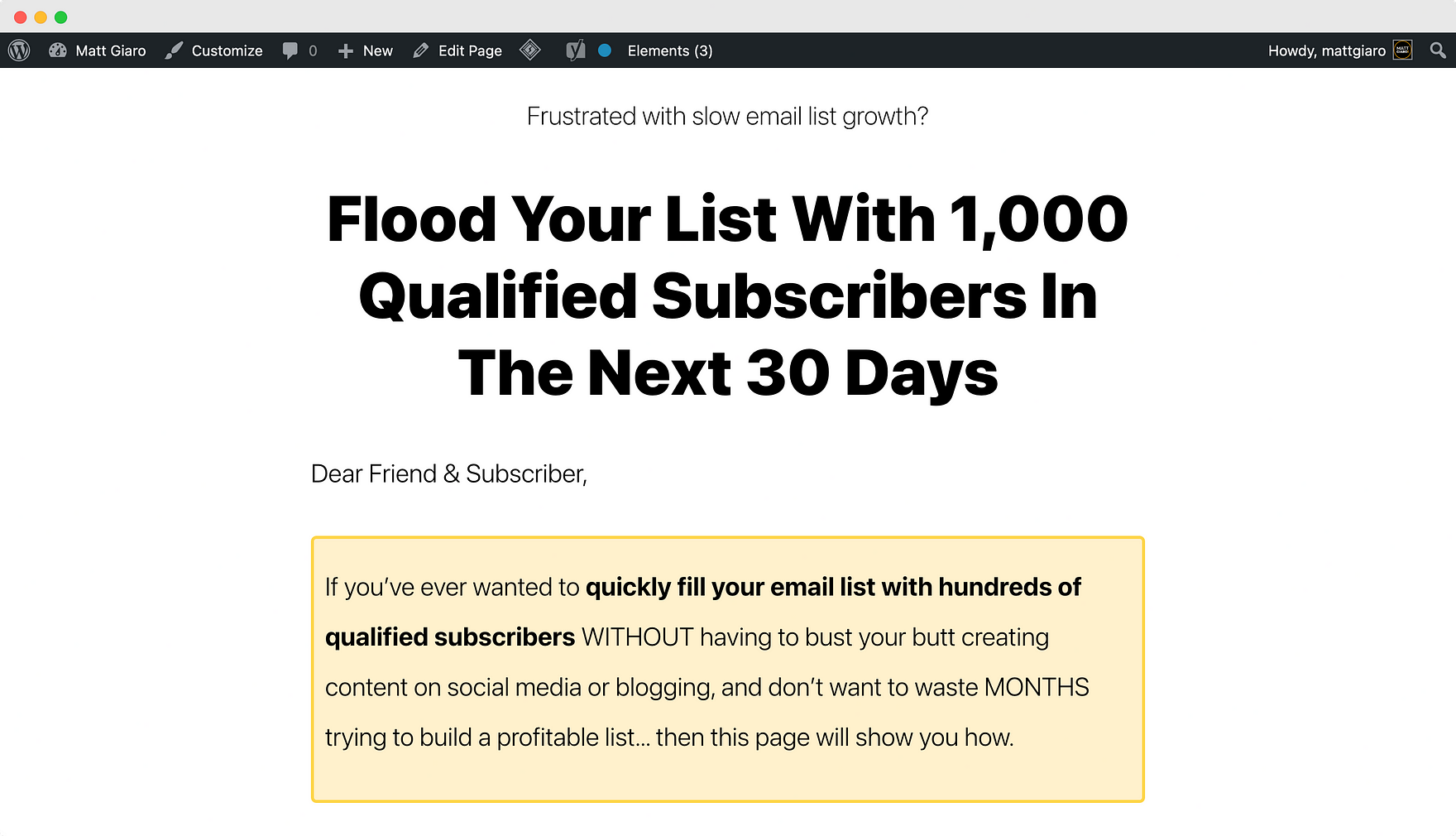This simple process can make you $5k-10k each month
When I first started creating content back in 2012, I had a secret dream: selling online courses on autopilot and making money while I sleep.
But the reality turned out to be bloody different.
My first courses were damn hard to create, ate up all my time, and the icing on the cake: nobody was buying them.
That was 12 years ago.
Since then, I’ve come a long way. My course sales generate 10 grand a month. And they’re so quick to create that it only takes me 5 days of easy work. This allows me to work from home creating content and helping thousands of people all over the world.
After creating over 74 online courses, I found a simple, systematized method that adds $5,000 — $10,000 in new revenue each month with just 5 days of work, and without the hair-pulling anxiety.
Let me show you how.
Step 1: Find your winning course idea
When I first started creating courses, I thought that I had to package all my knowledge into one single course.
Big mistake.
It took me weeks to outline, gather all the information, design slides, write scripts, and record all the content.
It was too much work upfront. It was also useless and overwhelming for the students. People don’t buy your course to see everything you know. They buy a course to solve a specific problem.
In 2014, I had back surgery. I was two inches away from ending up in a wheelchair. When I first saw the surgeon, I didn’t want to hear everything he learned in medical school. I wanted him to fix my L4-L5 and S1-S2 disks.
Imagine your course as a surgery. Your students don’t care about the amount of info. It’s about the problem you solve and the outcome they’ll achieve. A winning course idea is never about a topic — it’s about a problem that needs to be solved. Let that sink in.
So how do I come up with winning course ideas? Simple. I look at problems first.
Whenever I solve a problem for myself or a client, or find a new strategy that works, I note it down to turn it into a course.
Sometimes, inspiration comes from the common questions people ask me. For example, one client was overwhelmed about what tools to pick to create content, so I made a course about it.

I launched it to my small list of 1,203 subscribers. 23 students bought it.
Not a best-seller, but not bad either. At $150 per sale, that’s $3,450 and a product I can promote anytime.
Another example…
If you’ve ever tried to build an email list, you know how hard it is. So, since October, I started sponsoring newsletters to grow my email list.
Six months later, I had spent over $2,131.59 and gained over 500 subscribers using this method. So I created a course about it called “Subscribers From Scratch.” It was a huge success.

Once I have a course idea, I head to step 2.
Step 2: Make your course idea stand out from the crowd
The internet is flooded with online courses.
No matter what topic you’re covering, there are dozens of other courses out there on the same subject. That’s good because it proves the market is profitable. But it’s also bad because your course might get ignored in a sea of indifference.
To cut through the noise, you need a way to make your course stand out.
How do you do that? By positioning your course differently in the marketplace.
For example, one of my best-selling online courses is a program called SPEED SEO.
At first sight, there are thousands of SEO courses out there.
So I had to find a unique angle to separate it from the crowd. One of the main problems with SEO is that it takes time. But after doing SEO for over a decade, I have a process to rank on Google’s first page in as little as 48 hours.
So that’s the positioning I’ve chosen.
This course is not a comprehensive SEO course that teaches you every tiny SEO tactic… It’s designed to help students “Rank on Google Fast.” (Hence, the word SPEED). It’s the step-by-step process for quickly getting pages ranked.
Find one unique angle to your course and make it stand out.
Step 3: Create a compelling curriculum in 2 hours
Once I have the course topic and unique positioning nailed down, the next step is mapping out the step-by-step blueprint.
This part is critical. No matter how compelling the positioning is, the course needs to deliver a clear, logical sequence to help students achieve the desired outcome.
That’s where the outline comes into play.
It used to take me weeks because I tried to put too much info into the course. Now that we’ve nailed the positioning, it’s easier to have clear boundaries about what to teach and what not to. This already saves a lot of time.
My process is to do a brain dump of all the relevant ideas, strategies, and teaching points into a mind map. I’ll go through any notes I’ve taken when helping clients with this issue or review the thought process behind that new strategy I discovered.
Everything gets jotted down in one master mind map first. When you’re brainstorming your ideas flow in a complete un-logic way. Instead of fighting the mess, I simply go with it. I write down ideas as they come.
Then, I start rearranging those disjointed thoughts into a cohesive linear flow of 4–9 core steps that will take someone from stuck to solution. Those key steps become the main module breakdowns for the course structure.
For example, for the “Speed SEO” course, the modules might be:
1) Finding untapped keyword opportunities
2) On-site optimization techniques
3) How to write SEO titles
4) How to outline the article
5) How to write it
6) Etc.

Notice how each step logically leads to the next. Each guides the student through a defined transformation process.
This sequential ordering is crucial for an effective course experience. It’s the step-by-step roadmap you’re students are paying for.
This mindmap doesn’t just serve as my course plan. It also becomes the primary visual reference for recording the course(more on that later).
Step 4: Create the marketing material that’ll sell your course
An online course is useless if you can’t sell it.
Reddit and Facebook groups are full of course creators who spent weeks creating their courses… but once launched, they have no students. That sucks.
So what I do before even recording the course, is to write the launch material that will help sell it.
What do I mean by launch material? Two things:
- a few launch emails
- and a sales page
I use emails for my course launches for these reasons:
1) Email marketing is a proven way to sell online. Email promotions generate far higher sales than social media posts:

2) I can re-use the emails for future launches and update them quickly if needed (unlike videos)
3) It’s easy to go back and edit/tweak the emails based on performance data before re-promoting the course again.
4) I can use the emails to create the sales page
I also like to write emails before recording the course to make it as appealing as possible for students to buy. And I usually find those compelling arguments by writing about it. That’s why I create the launch material up front.
I used to record the course first, but then I’d get stuck creating the launch material. While writing, I often came up with great ideas that I couldn’t add because the course was already done. Now, I create the launch material first, to make sure that I can weave in any additional idea that can help in making it more enticing.
The genius thing about my method (sorry for bragging) is that I turn my emails into a sales page… so I kill two birds with one stone.

The way I structure my launch emails follows a simple, framework:
- Identify the desire/opportunity: Why should students care about the course topic?
- Explain the problems/obstacles holding them back: What’s the issue with the “mainstream methods”?
- Introduce my unique course as the solution: What makes my method unique?
- Provide an overview of the course and what’s included: How will this course help you specifically?
I then write the emails following this narrative. Then, all I have to do is assemble the emails to create the sales page.
Step 5: Recording the course
This is the part that many people overthink and overcomplicate. I was one of them. You don’t need a professional video studio setup or fancy equipment to record an effective course.
My process is to keep things super simple, so I don’t procrastinate. The best way I found is to open the mindmap I used to brainstorm the course and record my screen commenting on it. (Plenty of apps allow you to do this like Screenflow, Camtasia, or Loom.)
That’s really all there is to it. No need for multi-angle cameras, lighting rigs, or microphone acrobatics.
I also do NOT edit my online courses. I prefer to leave in any little imperfections like coughing, ums, errs, etc. when recording. It makes the courses feel more natural and conversational like you’re having a friendly chat with the viewer. No need to stress about being a flawless presenter.
The goal is to get the core teaching content recorded in a logical, step-by-step way without getting bogged down by production details. You can always go back and re-record sections later if you totally messed up.
By adopting this casual recording style, I can record the whole course in one morning — usually in less than 3 hours.
Compare that to the weeks or months of agony from obsessively polishing the materials right out of the gate.
Record your course like a Zoom meeting, not a TED Talk.
Step 6: Putting it all together
With the launch emails written and the core course content recorded, the final step is putting all the pieces together for a stress-free launch.
First, I’ll polish up the launch emails, adding final edits based on the course recording.
Next, I’ll tackle the visuals: creating a simple logo and designing the sales page layout. I use a pre-defined style for all my courses, so I just need to change the title and icon. It takes 5 minutes.
Once the sales page is ready, I’ll upload the course video files to my online platform. Then, I get all the other logistics configured like the order form, the launch coupon code, etc.
The last part is loading the final launch email sequence into my autoresponder.
And that’s it! By following these sequential steps, I have a new course ready for launch without any of the frantic overwhelm.
The best part of this structured process is that I can repeat it every month. No more seasonal roll-out headaches or exhausting, multi-year course creation sagas!
Want my free case study on how to create online courses fast? Click here to get it now.

